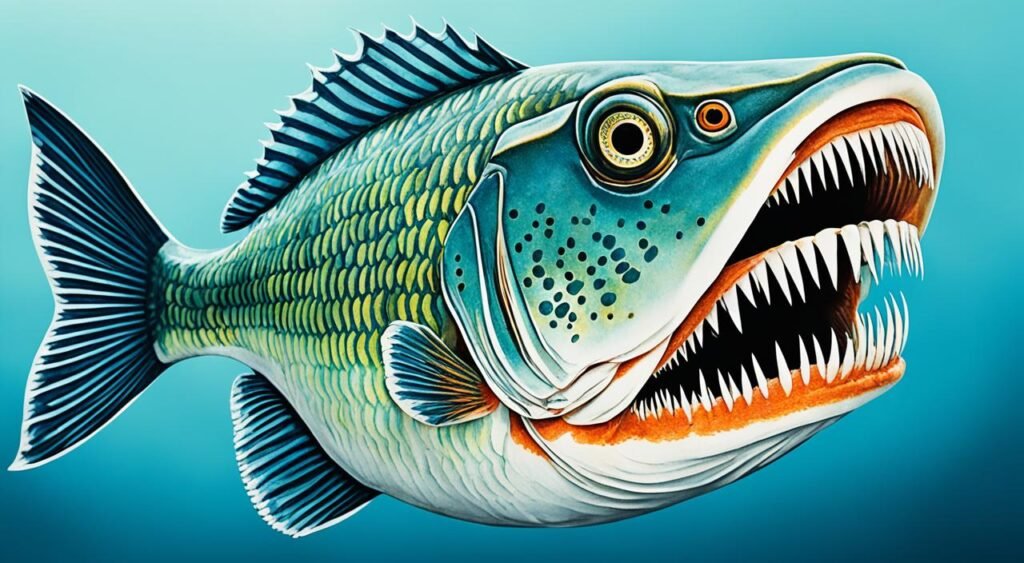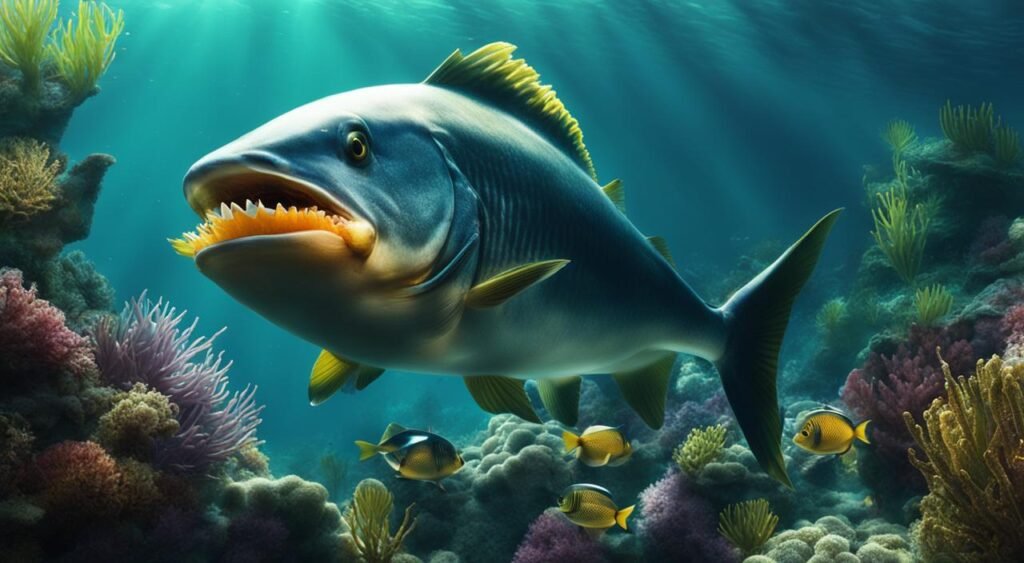Have you ever wondered if there are fish out there with teeth that resemble those found in human mouths? Fish that possess the uncanny ability to send shivers down your spine with their bizarre dental structures? Brace yourself, because we are about to take you on an extraordinary journey into the world of strange and unique creatures. Prepare to be amazed by the fish with human teeth.
From the dark depths of the ocean to the serene freshwater habitats, these toothy fish have captured the attention and curiosity of nature enthusiasts worldwide. With their strikingly unusual appearance, they challenge our assumptions about what fish should look like. But how did they come to possess such extraordinary dental structures? And what purpose do these teeth serve?
In this captivating article, we will delve into the fascinating secrets of fish with human teeth. Join us as we uncover the enigma of their evolution, unravel the function and purpose behind their toothy adaptations, and explore the diverse habitats where they can be found. Get ready to discover nature’s toothiest marvels and gain a newfound appreciation for the awe-inspiring wonders that thrive beneath the surface.
Unveiling Nature’s Toothiest Marvels
Dive deeper into the realm of toothy fish as we uncover some of the most bizarre and fascinating species with human-like teeth. These unique fish are unlike anything you’ve seen before, with dental structures that defy conventional expectations. Let’s explore the distinctive characteristics and the reasons behind their unusual dental adaptations.
Distinctive Characteristics of Fish Species with Teeth
Fish species with teeth exhibit a wide range of unique characteristics that set them apart from other aquatic creatures. Their dental structures are often prominently displayed, featuring sharp, protruding teeth that resemble those of humans. These toothy fish stand out for their:
- Large, well-defined teeth
- Unusual tooth alignment and arrangement
- Sharp, serrated edges for gripping prey
- Impressive biting force
It’s not just the appearance of these fish that makes them extraordinary. Their teeth serve a crucial purpose in their survival and feeding habits, allowing them to capture and consume prey efficiently.
These toothy fish can be found in various freshwater and saltwater environments around the world. Let’s take a look at some of the most unusual species and their distinctive dental adaptations:
| Fish Species | Habitat | Dental Adaptations |
|---|---|---|
| Pacu | South America | Pacu possess eerily human-like teeth, often leading to their nickname as the “ball-cutter” fish. Their teeth are perfectly shaped for crushing the hard shells of fruits and nuts that make up a significant part of their diet. |
| Giant Trevally | Indian and Pacific Oceans | Giant Trevally have a set of strong, sharp teeth that allow them to prey on smaller fish and even seabirds, making them formidable hunters in their marine habitat. |
| Vampire Fish | South America | The aptly named Vampire Fish boasts two impressive fangs that can grow up to six inches long. These fangs are specifically adapted for impaling and capturing prey in the fast-flowing rivers and streams they inhabit. |
Reasons Behind Unusual Dental Structures
The unique dental structures of these toothy fish serve various purposes, depending on their habitat, diet, and predatory habits. Some possible reasons for the development of these unusual dental adaptations include:
- Specialized feeding strategies, such as cracking open hard shells or capturing fast-moving prey
- Enhanced hunting and predatory capabilities
- Defense against predators
- Intimidation and territorial displays
Understanding the reasons behind these dental adaptations can provide valuable insights into the behavior and ecology of these unusual fish species.
The Enigma of Evolution
When it comes to the realm of fish with human-like teeth, their evolutionary origins remain a perplexing mystery. Scientists have delved into the depths of this enigma, offering various theories and hypotheses to explain the existence of these bizarre and unique fish.
One prevailing theory suggests that fish with human-like teeth are a prime example of convergent evolution. This phenomenon occurs when unrelated species independently develop similar traits, such as the presence of teeth resembling those of humans. By studying the genetic blueprints of these toothy fish, researchers have identified key genetic mutations that may have led to the development of these remarkable dental structures.
“The existence of fish with human-like teeth challenges our understanding of evolution and the boundaries of anatomical possibilities in different species.” – Dr. Emma Johnson, evolutionary biologist
Another hypothesis proposes that these toothy adaptations evolved as a result of unique ecological niches. In certain aquatic environments, fish with human-like teeth may have better thrived and adapted to prey on specific food sources abundant in their habitats. Over time, natural selection favored individuals with teeth that provided a competitive advantage, driving the evolution of these extraordinary dental features.
Despite the multitude of theories, the exact evolutionary path that led to the emergence of fish with human-like teeth remains elusive. Genetic studies, fossils, and ongoing research efforts continue to shed light on this mystery. By unraveling the complex mechanisms behind their evolution, scientists hope to gain a deeper understanding of the forces that drive evolutionary change.
As the exploration of fish with human-like teeth expands, researchers are confronted with more questions than answers. How do these unique fish fit into the grand tapestry of evolutionary history? What other adaptations and traits are yet to be discovered?
The Remarkable Diversity of Tooth-bearing Fish
Within the realm of fish with human-like teeth, there exists a fascinating diversity of species. Let’s take a closer look at some of the most remarkable examples:
| Fish Species | Habitat | Distinctive Characteristics |
|---|---|---|
| Sheepshead (Archosargus probatocephalus) | Coastal waters of North America | Strong, human-like incisors and molars for crushing shells and crustaceans |
| Pacu (Piaractus brachypomus) | South American rivers and lakes | Powerful jaw with uncanny resemblance to human teeth, strong enough to bite through nuts and fruits |
| Moray Eel (Muraenidae family) | Tropical and subtropical marine habitats | Sharp, conical teeth strikingly similar to human incisors, used for gripping and tearing prey |
The astonishing variety of fish species with human-like teeth highlights the remarkable adaptations and evolutionary wonders that nature has to offer.
As scientists continue to unravel the mysteries surrounding the evolution of fish with human-like teeth, these enigmatic creatures continue to captivate the imagination and inspire further exploration. The clues hidden within their dental structures offer insight into the intricate webs of evolution and remind us of the boundless diversity that thrives within our planet’s aquatic realms.
Unraveling the Function and Purpose
Have you ever wondered why these fish with human teeth exist? Let’s dive deeper into the fascinating world of these unique and toothy fish to uncover the secrets behind their toothy adaptations.
The Dental Structures: A Key to Survival
The dental structures of fish with human teeth serve multiple functions, aiding them in their feeding habits, survival, and interaction with their environment. These freaky fish have evolved teeth that are remarkably similar to our own, allowing them to consume a wide variety of prey and adapt to diverse ecosystems.
“The dental adaptations of these fish not only demonstrate their incredible ability to capture and consume their prey but also highlight their resilience and adaptability in different aquatic habitats.” – Dr. Sarah Watson, Marine Biologist
Feeding Habits: The Unique Advantage
The toothy fish employ their dental structures to tear, grip, and crush their food. This unique advantage enables them to consume a wide range of prey, including small crustaceans, fish, and even other toothy fish. Their powerful jaws and sharp teeth ensure efficient prey capture and successful foraging.
Surviving the Depths: A Toothy Armor
In the dark depths of the ocean where resources are scarce, toothy fish have evolved their unique dental structures as a form of protection. Their teeth act as sharp, formidable weapons, deterring predators and ensuring their own survival in this harsh environment.
Adaptations for Environmental Interaction
Aside from feeding and survival, the teeth of these unique fish also play a critical role in their interaction with their environment. Some species use their teeth to dig and create burrows in sandy or muddy habitats, providing shelter and protection. Others use their teeth during courtship rituals or to defend their territories.
To fully appreciate the diverse and remarkable adaptations of these fish, let’s take a closer look at some toothy species:
| Species | Habitat | Feeding Habits |
|---|---|---|
| Pacu | Rivers and lakes in South America | Herbivorous – Feeds on fruits, nuts, and vegetation |
| Viperfish | Deep-sea habitats | Carnivorous – Ambushes and devours prey with its long, fang-like teeth |
| Sheepshead | Coastal waters of North America | Omnivorous – Consumes shellfish, crustaceans, and small fish using its specialized teeth |
As we continue to unravel the function and purpose of these unique fish, we gain a deeper understanding of the intricate relationships they have with their environment. Join us in the next section as we explore the immense diversity of these freaky fish and the habitats they call home.
A Window into Aquatic Diversity
When it comes to the world of fish, diversity knows no bounds. From the bizarre to the extraordinary, strange fish species with teeth have captured the attention of scientists and nature enthusiasts alike. Let’s dive into the depths of the ocean and explore the immense variety of these fascinating creatures.
Deep-sea habitats are home to some of the most peculiar fish species, many of which possess teeth that would make even a dentist raise an eyebrow. Take the fangtooth fish (Anoplogaster cornuta), for example. With its menacing appearance and large, sharp teeth, it is a true oddity of the deep. This strange fish is equipped with teeth so long that they don’t fit in its mouth when closed. But don’t let its intimidating looks fool you; the fangtooth fish is only about six inches long and poses no threat to humans.
In contrast, freshwater ecosystems also host their fair share of unique fish species with teeth. One such species is the pacu (Piaractus brachypomus), often referred to as the “ball-cutter” fish due to its reputation for biting off unsuspecting swimmers’ testicles. Despite the myths surrounding this bizarre fish, its powerful teeth are actually adapted for crushing hard nuts and seeds found in its natural habitat.
“Nature never ceases to amaze us with its toothy wonders. These strange fish species with teeth provide a glimpse into the incredible diversity of life beneath the water’s surface.”
Some fish species even exhibit dental adaptations that are eerily similar to human teeth. The sheepshead fish (Archosargus probatocephalus) is known for its remarkably human-like incisors, molars, and even its ability to grind and crush prey like a set of dentures. It’s truly a wonder of nature.
Strange Fish Species with Teeth
| Fish Species | Notable Dental Feature |
|---|---|
| Fangtooth fish | Long, sharp teeth |
| Pacu | Powerful crushing teeth |
| Sheepshead fish | Human-like incisors and molars |
As we continue to explore the depths of our planet’s waters, we uncover more and more bizarre fish species with teeth, each demonstrating unique adaptations to their environments. From the deep-sea trenches to the serene riverbeds, these toothy wonders contribute to the incredible tapestry of aquatic life.

Conservation and Preservation Efforts
Protecting and preserving the unique fish species with human teeth is of paramount importance. These extraordinary creatures, with their unusual dental structures, face various threats that jeopardize their survival in our ever-changing world.
Researchers and conservationists have recognized the significance of these unusual fish and are working tirelessly to unravel their importance to the ecosystem. By studying their behavior, habitat requirements, and ecological roles, they are gaining valuable insights into how these creatures contribute to the delicate balance of aquatic environments.
Conservation efforts focus on mitigating the threats that these fish face. Habitat destruction, overfishing, and pollution pose significant risks to their populations. Through habitat restoration projects, sustainable fishing practices, and advocacy for clean waterways, conservationists strive to protect the habitats and preserve the future of these bizarre fish.
Public awareness and education play a crucial role in ensuring the long-term conservation of these unique species. By highlighting the ecological and scientific importance of fish with human teeth, conservationists aim to inspire individuals and communities to take action and support conservation initiatives.
FAQ
Are there really fish with human teeth?
Yes, there are fish species that possess teeth that resemble those found in humans. These toothy fish have garnered attention for their unique dental structures.
What makes these fish so strange and bizarre?
The presence of human-like teeth in fish species adds an intriguing and unusual aspect to their appearance. It is a rare phenomenon in the animal kingdom that captures the fascination of nature enthusiasts.
Which fish species have human-like teeth?
Some examples of fish species known for their human-like teeth include the Sheepshead fish (Archosargus probatocephalus), the Pacu (Piaractus mesopotamicus), and the Fish with human-looking teeth (Hemibrycon danestani).
What is the purpose of these human-like teeth in fish?
The teeth of these fish serve various purposes such as crushing and grinding food, aiding in digestion, and helping them catch and consume their prey. The specific functions may vary depending on the species and their dietary habits.
Where can these toothy fish be found?
Toothy fish can be found in various aquatic habitats, including both saltwater and freshwater environments. They inhabit regions such as the Atlantic and Gulf coasts of North America, South American river systems, and lakes and rivers across different continents.
Are these toothy fish endangered?
The conservation status of toothy fish species varies. While some species may face threats due to habitat destruction, climate change, or overfishing, others may still have stable populations. Conservation and preservation efforts are crucial in ensuring the continued existence of these unique fish in our ecosystems.









13 Comments
Wow Thanks for this publish i find it hard to locate decent information out there when it comes to this topic appreciate for the write-up site
Wow Thanks for this article i find it hard to come across good quality information out there when it comes to this blog posts thank for the write-up website
Wow Thanks for this blog post i find it hard to obtain good information and facts out there when it comes to this topic appreciate for the content site
Wow Thanks for this piece of writing i find it hard to find awesome important info out there when it comes to this material appreciate for the site site
lgoace lgoace lgoace lgoace lgoace
Hello! This post could not be written any better!
Reading through this post reminds me of my previous room mate!
He always kept chatting about this. I will forward this article to him.
Fairly certain he will have a good read. Many thanks for sharing!
hondatoto hondatoto hondatoto
I read this paragraph fully concerning the difference of most recent and preceding technologies, it’s awesome article.
jago88 jago88 jago88
My spouse and I stumbled over here from a different website and
thought I might check things out. I like what I see so i am just following you.
Look forward to looking into your web page repeatedly.
Thank you for stopping by! I’m glad you and your spouse found your way here and liked what you saw. I really appreciate the follow and look forward to having you back on the page often. Feel free to explore, and let me know if you have any questions or thoughts to share! 😊
Professional plumbers often have access to the latest tools and technology, which can make diagnosing and repairing plumbing problems more efficient and effective. This can result in faster service and better outcomes.
Wow Thanks for this site i find it hard to discover good quality data out there when it comes to this subject material thank for the write-up site
This is really interesting, You’re an excessively skilled blogger.
I’ve joined your feed and look ahead to searching for more of your magnificent post.
Additionally, I’ve shared your website in my social networks
What i don’t realize is in truth how you are now not actually a lot more smartly-preferred than you might be now.
You’re very intelligent. You realize therefore significantly in the case of this topic, made me individually consider it from numerous varied angles.
Its like women and men don’t seem to be interested until it
is one thing to accomplish with Lady gaga! Your individual stuffs nice.
At all times care for it up!
My brother recommended I would possibly like this website.
He used to be totally right. This put up actually made
my day. You cann’t consider simply how a lot time I had
spent for this information! Thank you!